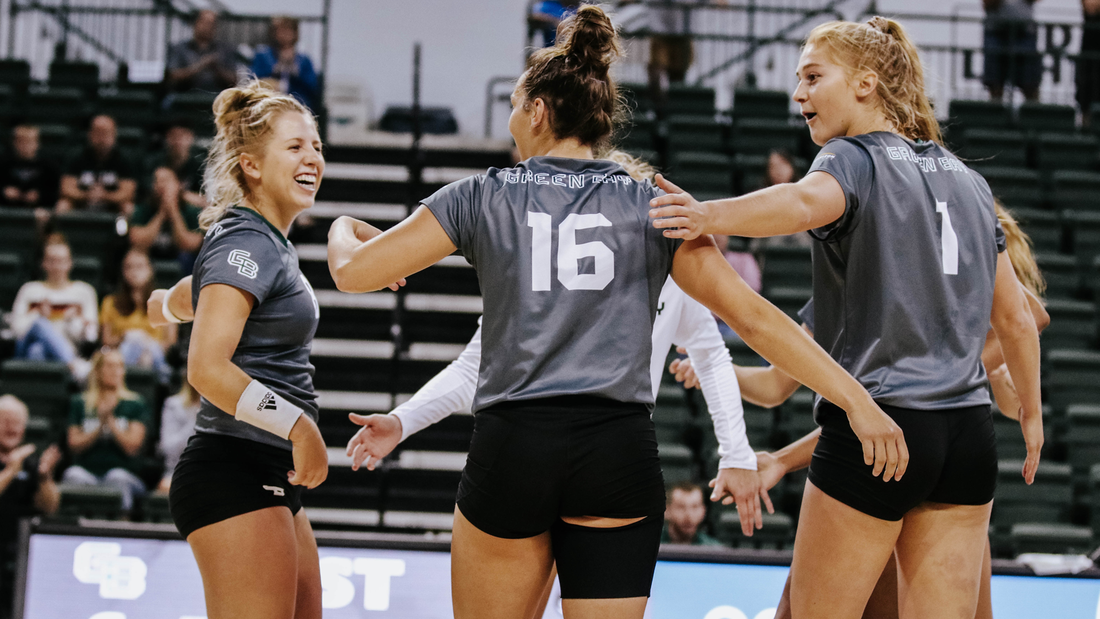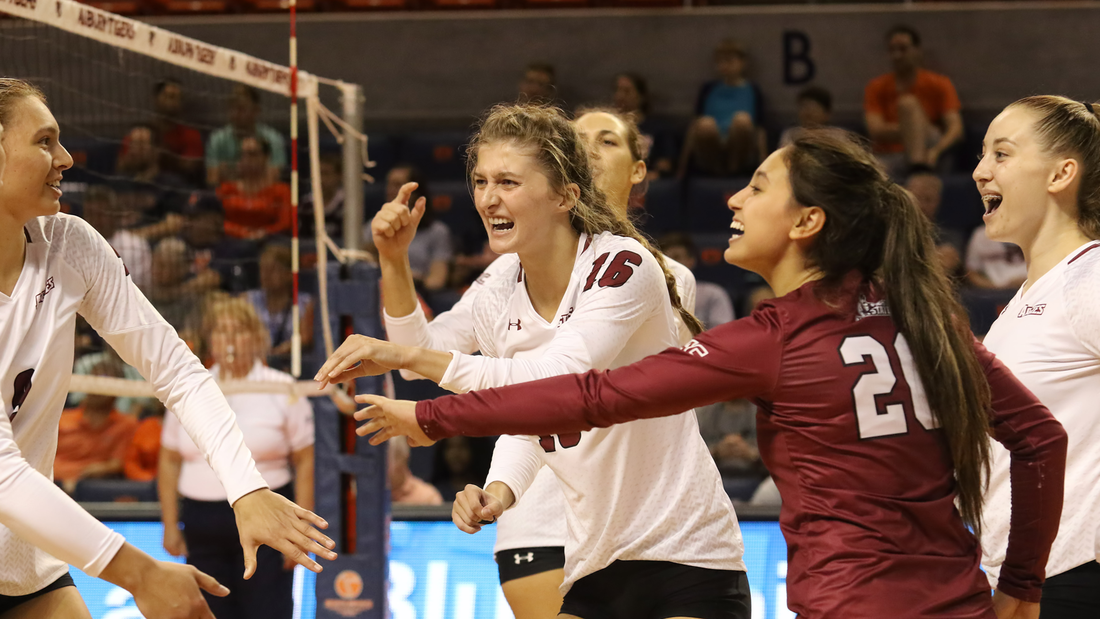|
Photo by Julia Kostopoulos
NOTE: 2019 will mark the third year of the revitalized, revamped National Invitational Volleyball Championships, which is a D-I postseason tournament dedicated to expanding the profile of deserving women's volleyball programs. We will check in on various teams through this season, with a particular eye to high-achieving mid-major programs. by Kyle Koso When the Green Bay volleyball team launches into Horizon League play this week, you might think the Phoenix is bringing along extra baggage on the demanding trip that has them playing four road matches in the first five on the schedule. With four losses in pre-conference action, all 3-0 sweeps at the hands of Pitt, Marquette, North Dakota State and Northern Iowa, there was the potential for Green Bay to second-guess the plans and procedures for the 2019 campaign. But there’s no wobble or trouble in sight; Green Bay was the preseason favorite to win the Horizon, and there’s a shared vision with second-year head coach Abbey Sutherland that the demands of difficult matches will lead to a supply of skills needed to prevail as the calendar turns to October and beyond. It helps to have an NCAA Tournament berth in the resume from 2018, along with last year’s Horizon player of the year (Taylor Wolf, now a junior) and setter of the year (senior Maddie Yoss). Besides, all those heavy-hitting opponents (Pitt is currently No. 4 in the AVCA rankings, with Marquette at No. 10) were on the schedule for a reason. “Pitt was a great opportunity, because we got to play in the venue where the national championships will be played, which was a great experience overall. Playing Pitt and Ohio State, yes on paper that looks daunting, but you learn something in every loss,” said Sutherland, whose team topped the Buckeyes, 3-1. “Pitt plays really fast, and that helped prepare for Ohio State later that day. And our own opening weekend was tough, with pretty high-level teams for a home tournament. It’s easier to play at home, but the wins over Ohio and Fresno State were huge for us. “With four matches at the beginning, that’s also a good challenge. Marquette (their invite), that’s close by, so you can be more rested than in doing a long trip … playing them and Northern Iowa, we knew all that would prepare us for conference. We learned a lot; every loss has propelled us to work to get better. Hopefully, playing higher level teams will make us feel more prepared for our very tough conference slate.” But none of that happens in a vacuum – of course, the losses were sometimes hard to take, and it’s not like players exited the locker room with a case of the giggles as they worked through the reasons why they got swept. It’s not automatic, turning a negative into a positive. “That NDSU loss, that was an eight-hour bus trip. It’s a tough play to play, and we were super stressed out the whole match and couldn’t find our groove,” Sutherland said. “We had some great conversations and an awesome week of practice after, where we talked about trying to stay calm. We do meditation every day though an app called Headspace, and that’s helping us. We don’t want to be vanilla, and we work on being more creative. “Against Marquette and UNI, we were within a couple points in several sets. We talk about effort-based and intentional play, control the controllables. We fix a few points, those matches go a different way.” Sutherland guided the Phoenix to a 20-win season last year in her first season at Green Bay; the team won the league tournament and reached the NCAA Tournament for the first time since 2003. Getting the roster to adapt to a new face and system required Sutherland to pace herself, figuring how to introduce change but not shocking everyone into submission. “My big thing was, I had to recruit the returners when I got the job to get them on board. I had to make sure we were on the same page; it took a bit for them to understand the growth-mindset culture, where you have to operate outside your comfort zone and learn from your mistakes,” said Sutherland, who was 146-36 in five years at UW-Stevens Point, including two D-III Final Four appearances. “That’s how we operate in our culture, encouraging them to be daring and brave, to make mistakes. Getting to know them helped. We had a rough preseason last year, then they bought into the process and the drills … a lot of coaches when they inherit a program say, ‘those aren’t my kids,’ but it’s our job to coach them and they are my players. It’s my job to help them grow.” To that point, roster backbones Yoss and Wolf continue to show improvement, giving the Phoenix that classic combination of terminal hitter and insightful setter. Yoss averages more than 10 assists per set and leads the team in aces, while Wolf averages 4.40 kills per set with a robust .275 hitting percentage. The team is also getting terrific work from junior middle Anna Eaton, while freshman libero Brenna Hesse has been on the court throughout, solidifying a spot that was much more of a mystery this summer. Wolf has figured out how to absorb some difficult assignments, whether it's dealing with this year’s competitive grind or even last year’s NCAA loss to Wisconsin, where she was left feeling unfulfilled. “The toughest part is being on the road, the endless hours of repacking bags, throwing laundry around … it’s just the process of going to new places and learning to adapt to new environments,” said Wolf, who kills per set ranks in the national top 30. “We’re together for so many hours, and we really bond and grow from that experience. As a team we focus on our mindset, and we work on it every day. We do meditation, thinking positive thoughts and self-talk, which really helps the team. After a match, we look at the positive outcomes and what we can do to improve on and off the court. “Against Wisconsin, we put up a great fight and it was a tough loss. They were ready for us. From that, especially, I learned there is so much more you can do to improve. I want to have more confidence in myself to make the good play and continue to get better.” Wolf knew Hesse from several years ago via a connection with the Northern Lights club program, and the junior knew coming in that the freshman had the tools to thrive. “I played with her older sister in club, played with her when I was back home on winter breaks. I knew she was a great player, had a great attitude, and knew she could step up,” Wolf said. “She came in and showed what she had, has earned it and improves each day.” Sutherland is ready to turn her crew loose on the Horizon League – this first push comes at Illinois-Chicago (11-3) on Friday, Sept. 27, then home Sunday versus Milwaukee (13-1). After that, it’s three straight on the road in taking on Oakland, Cleveland State and Youngstown State. “Maddie is a competitor through and through, and has improved her mental game. She’s figured out how to play for the team and help them. (She and Wolf) are two of the most improved players on our team, and that speak to their character and work ethic,” added Sutherland. “We’ve worked on Taylor’s block game, which has made a difference, and she’s better at attacking from back row. She wants the ball, and I know she’ll keep continuing to grow and work to be that player. “Anna, one of our middles, has a high volleyball IQ, she studies opponents, she understands the blocking schemes and how to fix that. Her blocking has improved significantly. She’s a little nutty, but that makes it fun to coach. She gets wild and vocal, and what she brings is very fun.” Photo by Michael Wade
NOTE: 2019 will mark the third year of the revitalized, revamped National Invitational Volleyball Championships, which is a D-I postseason tournament dedicated to expanding the profile of deserving women's volleyball programs. We will check in on various teams through this season, with a particular eye to high-achieving mid-major programs. by Kyle Koso Some collegiate volleyball programs are able to bring in recruits who already have polished skills, those unique players hailing from clubs that did stellar work in molding one’s potential and then rounding athletes into top-line form. And then there are players who need a bit more time in the kiln. Those athletes, the ones that you have to project a bit and wait for the game’s subtler skills to truly register, can make a massive difference, and that’s been a huge piece of the regular success enjoyed by the New Mexico State women’s squad. The 2019 season is another example, as the Aggies are 6-0 out of the gate with two fresh faces filling roles in important spots – sophomore setter Krysten Garrison and sophomore outside Cat Kelly. Coupled with key returners Megan Hart and Savannah Davison, New Mexico State is flexing muscle early and looking for an intriguing follow-up to last year’s 24-8 finish that included a WAC Tournament title and a first-round game in the NCAA Tournament. “It’s a little tricky sometimes. We don’t get a lot of blue-chip recruits; we get athletes who we have to teach how to play ... we graduate great players, and we have to fill those shoes,” said Aggies head coach Mike Jordan, whose team will look to extend its best start since 2006 at this weekend’s Springhill Suites Invite in hometown Las Cruces, NM. “Garrison is setting, replacing Bri Ainsworth in the 6-2, and Krysten was not a setter in club. She didn’t play much last year as a freshman and had to come a long way in a short period of time as a setter. It’s a work in progress here and there, but by the end of the season we usually have developed pretty good players.” The record bears out Jordan’s claim – the Aggies are a tough out, having reached the NCAA Tournament four times since 2012 and regularly winning comfortably more than 20 matches a year. In the days when Hawaii was a conference foe, the two programs battled it out constantly, and the Aggies in Jordan’s 22 years are a popular non-conference choice, as their RPI provides opponents with a quality strength-of-schedule task. Jordan wanted this year’s preseason schedule to be a real test; the Aggies probably didn’t get Auburn’s best shot back in August with a couple transfers out of the lineup, but even so, the elements he looks for seem to be coming together. “How can you complain about 6-0? In the preseason we always schedule some pretty good teams; we want the challenge to learn about ourselves. I don’t think we’ve been as tested as much as I would like, and we are still learning,” he said. “I’ve been concerned if we are tough enough, will we say the right things and do the right things when we need to … we are growing in first-contact skill; the serve and pass game is improving, and that was my biggest concern. We’ve started some games slowly and got better as the match went on, and I’ve been happy to see that we can settle in. It’s the best blocking team maybe I’ve ever had, certainly in a long time.” That’s got a lot to do with Hart, a fifth-year senior from British Columbia. The 6-foot-5 Hart is hitting an eye-popping .495 and doing her standard damage on the block as the Aggies have swept five matches and outlasted UTEP in a grinding five-setter so far. Reaching the high ground of the NCAA Tournament last year left quite an impression on Hart, and she’s quite keen on reliving the experience. “It was really exciting for me. We played as a team, and that’s a key in being able to go that far in a season,” said Hart, who was the MVP of last year’s WAC Tournament. “It meant a lot since it was the first time (playing for a WAC tournament title) and to play in the NCAA Tournament as well. We have that fire lit in us at the beginning of the season, ready to compete hard, and I think when you get that far, the fire just burns hotter. Once you get there, it’s so fulfilling. “As players get older and mature, they know how to fill those roles. And the seniors do a good job of preparing others ... I come to it more as having a vision for the team and how we can work together. We do a great job of communication and that helps get people motivated.” “Megan has lot of experience. She plays middle and right, at 6-5 with some arm speed, she can score on the right or the middle, and we bounce her back and forth a lot. She’s someone our younger players can look up to and learn from,” Jordan added. “I just want them to go out and be competitive in long stretches. Even if we get down, historically we can come back and win … I’m not sure how this team is quite yet, but I like the mental makeup so far.” Davison, another Canadian import, has kept up her pace after a standout freshman season that featured 32 starts and 382 kills. Junior Julianna Salanoa won WAC defensive player of the week honors earlier this year and, like Hart, is a handful on both offense and defense. “The fact we can push through long rallies, long sets and long games characterizes us. We can keep working hard; it’s all about pushing through in long stretches,” Hart said. “We do have such a strong front row; we’re not limited to one spot, we don’t have to set in one position. We can move the ball around and are versatile enough to hit in different positions; that keeps other teams on their toes, and that helps a lot – we are more of a threat because we can change up what we’re doing if necessary. “We have to remind ourselves of the end goal and cannot get complacent. We have to remember to push hard, and there’s no time for relaxing. I’m so focused for this season. I have this excitement in my play and in my head; it may be bittersweet in the end, but I’m totally invested in the here and now.” One other intriguing layer to the New Mexico State story is tied to the size of the roster – at 24 players, it’s the largest in Jordan’s run at the school. The idea is to be welcoming, to look at multiple athletes and relish the contributions each one can make. Strength in numbers makes life more fun, and it increases the odds of Jordan again finding those hidden gems in the great expanse of southeast New Mexico. “That’s the biggest roster we’ve had. A couple of things are in play … I want people on the roster who want to be on the roster. So, we often have players who want to come to New Mexico State and be a part of this, certainly a lot of local kids, who we want to give a shot to,” Jordan said. “I don’t want to say no to anyone. As long as they are good people and work hard, and help the team in practice every day in some shape or from. I love that we have this large, happy dysfunctional family, and we get a lot out of them. “Looking back to (AVCA honorable mention All-Americans) Gwen Murphy (2011-15) and Kim Oguh (2004-07) – great players who were terrible volleyball players when they got here, but they were good or sometimes great athletes. They developed into great players, and that’s the route we have to go.” |
Archives
December 2023
|



 RSS Feed
RSS Feed